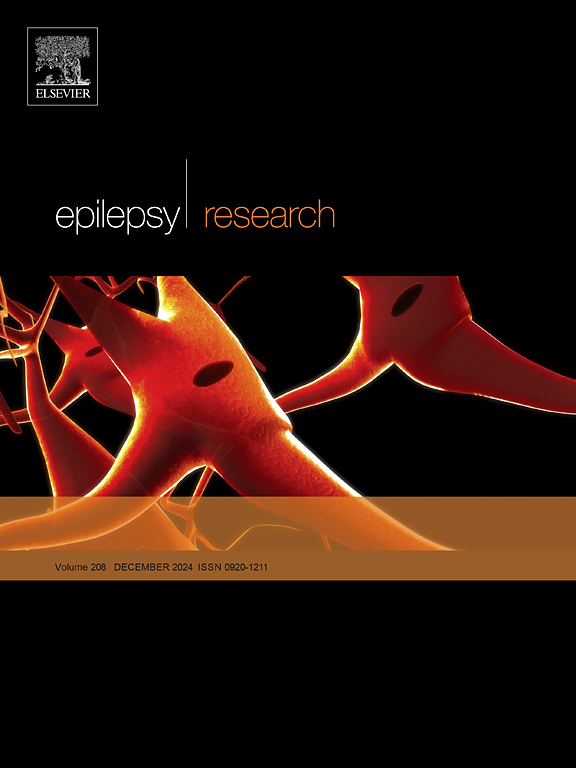反应性神经刺激的电图癫痫发作:一种早期和客观的测量对cenobamate反应的方法
IF 2
4区 医学
Q3 CLINICAL NEUROLOGY
引用次数: 0
摘要
目的反应性神经刺激(RNS)皮质电图(ECoG)数据可能在客观评估附加抗癫痫药物(asm)的疗效方面发挥作用。这项回顾性、多中心、观察性、为期24周的研究首次报道了cenobamate对rns检测事件(RDE)的影响。方法患者包括有复发性局灶性癫痫发作和植入RNS病史的成人(≥18岁),在RNS植入后4/1 - 20 / 12/15/23期间开始辅助使用辛奥巴马酸≥ 3个月,并接受≥ 2周的辛奥巴马酸(≥50 mg/天)。回顾从NeuroPace患者数据管理系统获得的RDE(“长发作”、“长发作伴饱和”和“饱和”),仅根据电图的心电图模式选择电图癫痫发作(ESs)。RDEs和ESs分别在基线期8周、开始治疗12周后每2周和研究结束时进行计数。主要结局是从基线到16周治疗期结束(12 +周)的总体ESs、ESs≥ 50 秒和ESs <; 50 秒的百分比变化。患者报告的临床癫痫发作频率被记录下来。结果纳入37例患者,平均年龄36.7岁。中位剂量为150 mg/天(范围50-250 mg/天)。显著值还原率从基线到年底cenobamate治疗ESs(94.4 %;p & lt; 0.0001),ESs≥50 年代(100.0 %;p & lt; 0.0001),和ESs & lt; 50年代(100.0 %;p & lt; 0.0001)。在可获得癫痫发作数据的患者中(n = 24),从基线到治疗结束,每28天临床癫痫发作减少的中位数百分比为72.2 % (p <; 0.0001)。27 %(10/37)的患者报告了不良事件;最常见的症状是头晕、疲劳和嗜睡。意义:RNS后癫痫发作不受控制的患者在辅助治疗期间,ESs和临床报告的癫痫发作显著减少。该分析的结果支持RNS ECoG数据作为一种客观测量的潜在用途,以补充临床数据,以确定药物疗效,并可能为更广泛地监测该人群对asm的反应提供策略。数据可得性本文中描述的分析数据可从通讯作者或SK生命科学公司获得,该公司赞助了用于治疗局灶性癫痫的cenobamate的临床开发。本文章由计算机程序翻译,如有差异,请以英文原文为准。
Electrographic seizures on responsive neurostimulation: An early and objective measure of response to cenobamate
Objectives
Responsive neurostimulation (RNS) electrocorticographic (ECoG) data may have a role in objectively assessing the efficacy of add-on antiseizure medications (ASMs). This retrospective, multicenter, observational, 24-week study is the first to report the effects of cenobamate on RNS-detected events (RDE).
Methods
Patients included adults (≥18 years) with a history of recurrent focal seizures and implanted RNS who initiated adjunctive cenobamate ≥ 3 months after RNS implant between 4/1/20–12/15/23 and who received ≥ 2 weeks of cenobamate (≥50 mg/day). RDE (“long episodes,” “long episodes with saturation,” and “saturation”) obtained from the NeuroPace Patient Data Management System were reviewed to select only electrographic seizures (ESs) based on electrographic ictal patterns. RDEs and ESs were counted during the 8-week baseline period, every 2 weeks for 12 weeks after starting cenobamate, and at study end. The main outcome was percent change from baseline to the end of the 16-week treatment period (12 + weeks) for overall ESs, ESs ≥ 50 seconds, and ESs < 50 seconds. Patient-reported clinical seizure frequency was recorded when available.
Results
Thirty-seven patients (mean age 36.7 years) were included. Median cenobamate dose was 150 mg/day (range, 50–250 mg/day). There was a significant median percent reduction from baseline to the end of cenobamate treatment in ESs (94.4 %; p < 0.0001), ESs ≥ 50 s (100.0 %; p < 0.0001), and ESs < 50 s (100.0 %; p < 0.0001). Among patients with available seizure data (n = 24), median percent reduction in clinical seizures per 28 days from baseline to end of treatment was 72.2 % (p < 0.0001). Adverse events were reported in 27 % (10/37) of patients; dizziness, fatigue, and sleepiness were most reported.
Significance
Patients with uncontrolled seizures after RNS had a significant reduction in ESs and clinically reported seizures during adjunctive cenobamate treatment. Results from this analysis support the potential use of RNS ECoG data as an objective measure to supplement clinical data when determining cenobamate efficacy and may provide a strategy for monitoring responses to ASMs more generally in this population.
Data Availability
The data for the analyses described in this paper are available by request from the corresponding author or from SK Life Science, Inc., the company sponsoring the clinical development of cenobamate for the treatment of focal epilepsy.
求助全文
通过发布文献求助,成功后即可免费获取论文全文。
去求助
来源期刊

Epilepsy Research
医学-临床神经学
CiteScore
0.10
自引率
4.50%
发文量
143
审稿时长
62 days
期刊介绍:
Epilepsy Research provides for publication of high quality articles in both basic and clinical epilepsy research, with a special emphasis on translational research that ultimately relates to epilepsy as a human condition. The journal is intended to provide a forum for reporting the best and most rigorous epilepsy research from all disciplines ranging from biophysics and molecular biology to epidemiological and psychosocial research. As such the journal will publish original papers relevant to epilepsy from any scientific discipline and also studies of a multidisciplinary nature. Clinical and experimental research papers adopting fresh conceptual approaches to the study of epilepsy and its treatment are encouraged. The overriding criteria for publication are novelty, significant clinical or experimental relevance, and interest to a multidisciplinary audience in the broad arena of epilepsy. Review articles focused on any topic of epilepsy research will also be considered, but only if they present an exceptionally clear synthesis of current knowledge and future directions of a research area, based on a critical assessment of the available data or on hypotheses that are likely to stimulate more critical thinking and further advances in an area of epilepsy research.
 求助内容:
求助内容: 应助结果提醒方式:
应助结果提醒方式:


